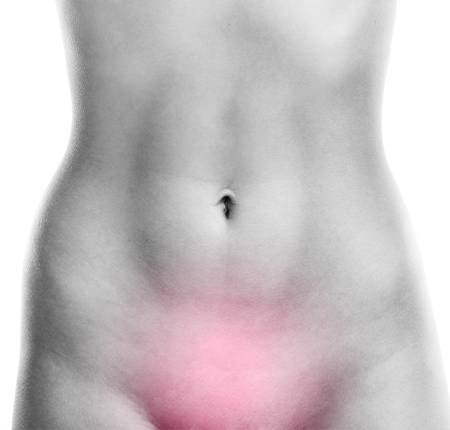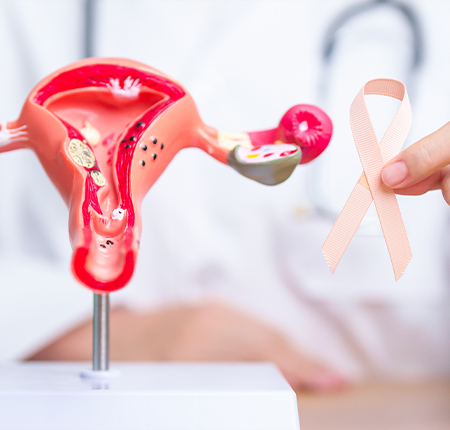
Also known as cervical cyst, epithelial cyst or mucous retention cyst, Naboth or Nabothian cyst is usually asymptomatic and harmless without any medical significance. The doctor discovers it only during a gynecological consultation, as a small swelling on the cervix.
Indeed, there are also situations when the cyst must be removed because it can cause complications. What these situations are and what else you need to know about Naboth cyst, we tell you on this page.
What is a naboth/nabothian cyst
Nabothian cyst is a benign gynecological condition that appears on the cervix in the form of a small swelling filled with mucus secreted by the cervical glands.
Basically, you can imagine your cervix as a smooth surface surrounded by glands and cells that normally secrete mucus. These glands may be covered and blocked by some kind of epithelial cells, and then they become filled and clogged with secretions. Moment when they accumulate in the form of small swellings, like white cysts, which are called nabothian cysts.
A patient may have a single Nabothian cyst, or several. Typically, such cysts do not pose a threat, are not dangerous and are not signs of cervical cancer. When they do not cause symptoms and complications, they can be ignored.
But there are also situations when the doctor recommends their removal, for example when they are too big and block the visibility of the cervix during a consultation.
Who does naboth cyst affect?
Women are affected by Naboth cyst, and anyone who has a cervix can develop this condition. Naturally, such cysts can appear especially at puberty and menopause, but there are also certain situations or stages in life that influence the way the glands on the cervix work. So you are more prone to blocked glands and the appearance of Nabothian cysts after:
Childbirth : Epithelial cells develop more rapidly after pregnancy, and the new cells can clog the glands and lead to naboth cysts.
An injury to the cervical area : Epithelial cells also multiply if you have suffered an injury to the cervical area in order to support tissue healing. Likewise, they can block the glands and secretions will remain there, forming Nabothian cysts.
An inflammation or infection in the cervix : As with injuries, cells reproduce to heal wounds or problems caused by a cervical inflammation or infection. Their role is to support recovery from conditions such as chronic cervicitis, but they can also clog the glands and lead to the appearance of a nabothian cyst.

How common is naboth cyst
Naboth cysts are among the most common and frequent conditions that gynecologists observe during a consultation without requiring treatment.
It's just a different aspect of the cervix that pregnant, pubertal or menopausal people are prone to, but it doesn't do any harm to your body.
Causes of nabothian cyst
As I already explained, your cervix is surrounded by cells and glands that produce mucus naturally and constantly.
Sometimes (especially in the above cases, i.e. after pregnancy, injury or cervical inflammation), healthy epithelial cells end up covering these glands to restore the cervical tissue.
The problem is that by covering them, they block the mucus at the level of the gland, and the secretions have no way to be eliminated. Trapped in the glands of the cervix, the mucus swells and thus creates a naboth cyst, which, however, does not pose any danger to you.
Risk factors for nabothian cyst
Any woman can develop Nabothian cysts, anytime starting from the age of puberty until the age of menopause, i.e. 40-50 years. Pregnant women are another risk group for this condition.
Another situation where you may be vulnerable to developing Nabothian-like cysts is when you suffer from adenoma malignum, which affects the production of mucus in the cervix and produces Nabothian-like cysts.
Naboth cyst - Symptoms
The nabothian cyst can be white or yellow in color, it can be clear or vaguely defined, and depending on the amount of mucus blocked in the gland, it can be between a few millimeters and up to 4 cm in diameter.
Apart from their unusual appearance, these cysts usually do not cause any other symptoms. They are not painful and do not affect your daily life. You may have no idea you have them until your gynecologist informs you that he noticed them during a routine consultation.
Very rarely, the naboth cyst can cause you discomfort, namely the feeling of pressure in the vagina, or pain before, during or at the end of sexual intercourse.
Visible symptoms may also occur if a nabothian cyst ruptures, which means it releases blocked mucus and small amounts of blood, with or without an unpleasant odor, as intermenstrual vaginal discharge. These symptoms are short-lived, but a visit to the gynecologist is necessary if they persist.
A final problem that can occur is when there are many cysts, or when there is a very large naboth cyst. These can affect the doctor's visibility of the cervix during a consultation, and can prevent the collection of cells for the correct performance of a pap smear. But this situation is also very rare.

When you should see a doctor
When symptoms cause you discomfort or persist, it is recommended to talk to your doctor. Schedule a gynecological consultation if you notice breakthrough bleeding, pelvic pain, or unusual vaginal discharge.
These can indicate a host of other abnormalities or infections that require diagnosis and treatment, and it's good to seek a specialist's opinion as soon as possible. Do you know how much vaginal secretions can tell about the health of your intimate area? We expect you to talk extensively about the types and causes of vaginal discharge HERE .
How to diagnose nabothian cyst
Nabothian cyst is common and common, and your gynecologist can tell what it is from a first examination. The diagnosis is made after a simple routine check.
If there is still doubt about the type of cyst and confirmation is needed that you really have a Nabothian cyst, further investigations can be done such as:
- Ultrasound, magnetic resonance imaging (MRI) or computed tomography (CT), for a closer examination of the cervix.
- Colposcopy, to see more clearly the appearance of the cervix and confirm whether it is a naboth cyst or another condition.
- Laboratory testing of a sample of the fluid inside the cyst to confirm that it is a cyst and not cancer (if this is suspected).
Naboth cyst treatment
Generally, no treatment is necessary for Nabothian cysts as long as they are asymptomatic and do not cause any discomfort.
But if they are so numerous or so large that they do not allow for a Pap smear and examination of the cervix, they will need to be removed.
The doctor may cut out the cysts to see if they are cancerous or remove them with cryotherapy (freezing and destroying the cyst with liquid nitrogen) or electrocautery ablation (using electric current to heat and destroy the cyst).
All these procedures are quick, can be done in a single visit to the gynecological office, and have a quick recovery. In just a few days, you should feel fine.
Naboth cyst and pregnancy
Many nabothian cysts are discovered by chance, precisely because of routine checks during pregnancy. And many of them are formed during pregnancy or after birth.
Because the cervix, which is normally open for fluids to be eliminated (menstruation) or to enter the body (semen), during pregnancy it closes and supports the development of the fetus. After birth, when new tissue covers the mucus-secreting cervical glands, the cells can overproliferate and block mucus removal, forming Nabothian cysts.
Although they are usually harmless, talk to your doctor if you notice pain during intercourse, bleeding or abnormal vaginal discharge during pregnancy. He will recommend, depending on your needs, the most suitable form of treatment.
Complications of naboth cyst
Cysts can form as a complication of hysterectomy (surgery to remove the uterus), but they do not lead to serious complications or endanger your health.
The most common complication is that the Pap test is painful or impossible due to the large size of the cysts. In this case, they will be removed. Nothing to worry about, even the largest naboth cysts can be treated by removal without causing further medical problems.
These mucus-filled bumps can also rupture, causing them to be released as abnormal, foul-smelling vaginal discharge and bleeding. As a rule, these symptoms occur for a short period of time.
How you can prevent nabothian cyst
There's no way to prevent a nabothian cyst, but there's nothing to worry about either. There are many other gynecological problems that you should focus on preventing, so just take care of your private area and make sure you schedule regular visits to your gynecologist. Nabothian cysts are not a cause for concern.

What is the difference between naboth cyst and cervical cancer
Although both nabothian cyst and cervical cancer affect the cervix, they are very different.
Nabothian cyst is not a health hazard and, in most cases, has no symptoms and no need for treatment. They are just small white or yellow bumps where mucus has accumulated when healthy epithelial cells have clogged the glands.
Cervical cancer, on the other hand, occurs when atypical cells multiply uncontrollably, and is very dangerous. It is considered one of the main causes of mortality for women in Romania, and I have prepared much more useful information for you in another blog article about what cervical cancer means and how you can prevent it .
Naboth cysts are common and usually your gynecologist will spot them right away during a routine consultation, eliminating the possibility of cancer. If there are still suspicions, a sample of fluid from the cyst can be sent to the laboratory to confirm its nature.
What to expect if you have naboth cyst
You can expect a normal life with a nabothian cyst, as it should not affect you in any way. As long as it's not causing you discomfort or other symptoms, there's no need for treatment, so don't worry. There is no need to look for remedies or alternative solutions. Also be aware that these cysts don't go away on their own, but they don't mean it's a problem either. You regularly go to the gynecological consultation, and the doctor will tell you when and if you need to remove them.






















